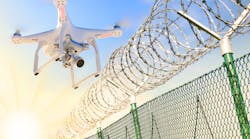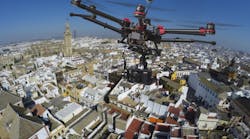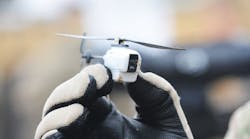The new threat scenario: Countering low altitude airspace risk
On September 11, 2001, the United States suffered the worst terrorist attack in our nation’s history. The 911 Commission report following this horrific event cited the fact that our intelligence and law enforcement agencies suffered from a “failure of imagination” in anticipating the attack scenario of planes flying into buildings. This is not the case with the low-altitude airspace threat posed by commercially available quadcopter drones today.
Security professionals globally have been encountering unauthorized quadcopter drone activities for close to a decade. The incidents are currently increasing at an alarming rate because of the proliferation of quadcopter drone sales for commercial and private use. This is a timely sales discussion to engage in with security professionals across multiple industries.
The precedent of low-altitude quadcopter drone threats is well documented:
- 2014: ISIS dispatches quadcopters for surveillance and explosive drops on friendly forces: https://www.defenseone.com/technology/2017/01/drones-isis/134542/
- 2016: France deploys anti-drone technology for Soccer Championships: https://www.espn.com/soccer/european-championship/story/2874837/france-to-use-anti-drone-technology-at-european-championship
- 2018: A drone assassination attempt against Venezuelan President https://www.bbc.com/news/world-latin-america-45073385
- 2018: Gatwick airport drone incident disrupts holiday travelers:https://www.latimes.com/business/la-fi-gatwick-drones-20181220-story.html
- 2021: Cybersecurity and Drones – The threat from above: https://www.forbes.com/sites/forbestechcouncil/2021/02/25/cybersecurity-and-dronesa-threat-from-above/?sh=4e8bae997b0d
- 2021: Mexican cartels using drones for attacks and drug smuggling: https://www.businessinsider.com/how-mexicos-cartels-are-using-drugs-for-attacks-drug-smuggling-2021-5
- 2021: Drone attempt to disable an electrical substation in Pennsylvania: https://www.newscientist.com/article/2296480-drone-used-in-attack-on-us-electrical-grid-last-year-report-reveals/
- 2022: 20 arrested delivering contraband to South Carolina prison: https://www.cbsnews.com/news/south-carolina-prison-drones-investigation-arrests-contraband/
Today, security professionals anticipate the “very imaginable” scenarios of espionage, disruption or destruction at public venues, transportation hubs, prisons, or critical infrastructure facilities. There is no “failure of imagination” when it comes to the need to secure low-altitude airspace. When the threat flies over the line of sight of video surveillance systems, and the heads of man-guarding forces, customers will be looking to physical security integrators and guard services companies for immediate solutions.
Unauthorized drone incidents are increasing at an alarming rate because of the proliferation of quadcopter drone sales for commercial and private use. Quadcopter drones film and record activities, hack into wireless network communications, disrupt public events and business operations, destroy physical infrastructure, and kill adversaries.
How Did We Get Here?
The father of drone technology was none other than Nicola Tesla, dating back over 120 years ago. The first military use case found its way into combat in WWI and future conflicts, for surveillance and reconnaissance operations. Drones were later expanded and weaponized, but what has moved the risk needle for security professionals most recently was the advent of the “quadcopter” drone. With complementary technologies such as video cameras, GPS, smaller powerful motors, carry capability, obstacle avoidance, etc. the commercial use cases (legal and illicit) have exploded. Simultaneously, the configurations downsized, capabilities improved, and prices dropped quickly. Enter the innovative terrorist, organized crime / common criminal, and clueless user.
The fact is the growth of the commercial drone market is exceptional in terms of scale and will continue for the next 5 -10-year cycle.
- The Commercial Drone Market size is set to surpass USD $55 Billion by 2027, according to Global Market Insights Inc. That would grow the market to approximately 50% the size of the entire physical security industry over the next 5 years.
As a result of commercial sales, the counter-drone market is already well over Half a Billion dollars annually and enjoying very rapid growth.
- Anti-Drone System Market Size and Forecast. The anti-Drone System Market size was valued at USD $524.78 Million in 2020 and is projected to reach USD 7.75 Billion by 2028, growing at a CAGR of 29.9% from 2021 to 2028
The wide majority (80%) of commercial Counter - Unmanned Aerial System (C-UAS) deployments today involve “passive” Radio frequency (RF) sensors and software. Passive in that they do not interfere with outside communications or require additional equipment.
In this case, there is a human operator involved to control the flight of the drone. Radio frequency sensors are the cornerstone of airspace security to detect commercial, consumer, and Do It Yourself (DIY) or prototype quadcopter drones. Most commercial counter drone installations will be secured in a one square kilometer footprint and deployed with (6) or fewer sensor combinations and software. Cloud deployments are the preferred model for ease of installation, automatic upgrades, and immediate alerting capabilities. However, on-premise and “air-gapped” (stand-alone) configurations are also supported by vendors.
RF sensors identify the flight path and the location of both the drone and the pilot and can recon once the unit is activated. RF sensors are also capable of identifying the specific drone model being operated, which provides critical forensic data used to bring legal action against trespassers.
Counter Drone Solutions
In physical security terms, a C-UAS is intrusion detection for low-altitude airspace. In this use case, the sensors happen to be on rooftops rather than embedded in door and window frames, but the alerting and response processes are similar. In a typical Cloud deployment, an airspace “trip wire” surrounding the facility has established an alert when breached. Sensors immediately alert and locate the flight path of the drone(s) and initiate visual contact. The GPS location of the operator is triangulated across multiple sensors and forwarded to the security team, who responds to the unauthorized drone operator.
The best counter-drone solutions provide an open architecture to allow a layered security approach that integrates seamlessly to additional modalities (RF, radar, acoustics, video, etc.) and future security options such as defeat technologies, where legally authorized. Today commercial C-UAS are essentially Critical Early Warning and Response Platforms.
More advanced threats require defense in-depth deployments to counter highly sophisticated and dangerous adversaries. A C-UAS platform must scale with the threat and sophistication of the adversary: clueless user, common criminal, activist, hacker, organized crime, cartel, or terrorist. Sensor expansion will increase the detection area footprint and data is shared between various sensors (PTZ cameras, radar systems, acoustics, lasers, microwave, etc.) Multi-directional sensors detect, classify, and locate drones in the airspace. Geolocation finds the drone pilot the same way your Uber or Lift driver locates you are the airport and immediately dispatches information to smart devices (first responders). RF sensors have embedded LTE and network traffic is encrypted.
Integrated cameras have eyes on the movement of the drone(s). They deliver visual proof in detecting and locating drone activity, identifying payloads, and recording forensic evidence of airspace breaches. C-UAS vendors support multiple camera manufacturers and some offer VMS integrations. PTZ cameras integrate video analytics to differentiate between moving objects, such as a plane, bird, car, helicopter, or drone. Software deployments also utilize machine learning, which is constantly upgraded, much like antivirus software and malware protection tools.
Radar, when required, provides extended long-range detection. Radar is critical to identify “autonomously controlled” drones (no operator). The industry problem has been high false positive rates. Radar is also an expensive addition to a sophisticated counter-drone deployment. It is important to have a detailed threat assessment based on adversary and risk priority to determine the extent of the C-UAS platform integrations required to counter them.
Acoustic sensors identify the sounds (buzz) unique to individual drone models to pick up sound signatures and locations. An example of acoustic integration would involve a shot spotter type of detection solution.
C-UAS vendors provide application software that is central to aggregating data from the various sensor modalities installed. The software connects all sensors, performs machine-learning analysis, and is the central nervous system for the complete solution. Alerting in most cases is fully autonomous, and no operator is required in the communication loop.
Establishing Support Parameters
The best C-UAS vendors will offer integration to SOC and G-SOC monitoring and provide global support. That said, a C-UAS can provide near real-time actionable intelligence that is intuitive and easily integrated into standard Security Operating Procedures (SOP) for security team visibility and response.
The emerging commercial use case scenario provides integrators with the toolset to support customers with “Drone Interdiction as a Service.” This security enhancement would be positioned as an upsell to internal customer security solutions and/or man-guarding contracts. A C-UAS solution answers the dilemma of an unauthorized quadcopter drone flying over the line of sight of a VMS and the heads of security guards.
The next frontier of physical security operations is to protect government, commercial facilities, and the public from the threat of low-altitude quadcopter drones. It represents a clandestine threat with a low barrier to entry and high impact outcome for surveillance, espionage / cyber breaches, operational disruptions, or physical destruction and in extreme cases, death. Countering these threats is a real-world priority for customer security teams. The physical security integrator is the prime resource to address low-altitude airspace risk moving forward.








